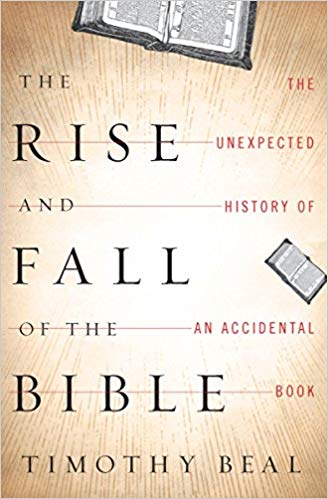File:2011 Beal.jpg
2011_Beal.jpg (328 × 499 pixels, file size: 29 KB, MIME type: image/jpeg)
Timothy K. Beal, The Rise and Fall of the Bible: The Unexpected History of an Accidental Book (Boston, MA: Houghton Mifflin Harcourt, 2011).
Abstract
"In this revelatory exploration of one of our most revered icons, a critically acclaimed author and professor takes us back to early Christianity to ask how a box of handwritten scrolls became the Bible, and forward to see how the multibillion-dollar business that has brought us Biblezines and Manga Bibles is selling down the Bible's sacred capital. Showing us how a single official text was created from the proliferation of different scripts, Beal traces its path as it became embraced as the word of God and Book of books. Among his surprising insights: Christianity thrived for centuries without any Bible--there was no official canon of scriptures, much less a book big enough to hold them all. Congregations used various collections of scrolls and codices. There is no "original" Bible, no single source text behind the thousands of different Bibles on the market today. The farther we go back in the Bible's history, the more versions we find. The idea of the Bible as the literal Word of God is relatively new--only about a century old. Beal's is an inspiring new take on the Bible. In calling for a fresh understanding of the ways scriptures were used in the past, he offers the chance to rediscover a Bible, and a faith, that is truer to its own history--not a book of answers but a library of question. An acclaimed author takes readers back to early Christianity to ask how a box of handwritten scrolls became the Bible, and forward to see how the multibillion-dollar business that has created Biblezines and Manga Bibles is selling down the Bible's sacred capital."--Publisher description.
Contents
pt. 1: The end of the Word as we know it : a personal introduction -- Magic 8 ball Bible -- The rise of a cultural icon -- The way of salvation -- So long, Judas -- The course of this book -- My utmost, revisited -- pt. 2: The greatest story ever sold -- Sodom and Gomorrah equals love -- Biblical consumerism -- Expectations of Biblical proportions -- By whose authority? -- pt. 3: Biblical values -- Felt needs -- Values added -- Finding your niche -- Necessary supplements -- If that's what it means, why doesn't it say so? -- Manga Bibles -- A different cookie -- pt. 4: Twilight of the idol -- The evangelical dilemma -- Selling out -- Type's setting -- Distress crop -- Behold your God -- pt. 5: What would Jesus read? -- Jesus sings -- Christianity before the Bible -- No original -- No canon -- Early Christian network society -- pt. 6: The story of the good book -- Remembering what's lost -- Scrolling down to the book -- Scattered throughout the whole world -- After Gutenberg -- Multiplying the leaves -- Lost in translations -- Not a rock but a river -- pt. 7: Library of questions -- Mark Twain's drugstore -- Letting suffering speak -- Trials of God -- Weak rope theory -- Is the Bible a failure? -- Faith in ambiguity -- Nothing but a burning light -- The Bible by the side of the road -- pt. 8: And I feel fine -- Cracking the binding -- Loose canon -- Back to the future -- Living conversations -- Seeds to go around -- Word without end.
External links
File history
Click on a date/time to view the file as it appeared at that time.
| Date/Time | Thumbnail | Dimensions | User | Comment | |
|---|---|---|---|---|---|
| current | 08:45, 29 October 2019 |  | 328 × 499 (29 KB) | Gabriele Boccaccini (talk | contribs) |
You cannot overwrite this file.
File usage
There are no pages that use this file.
